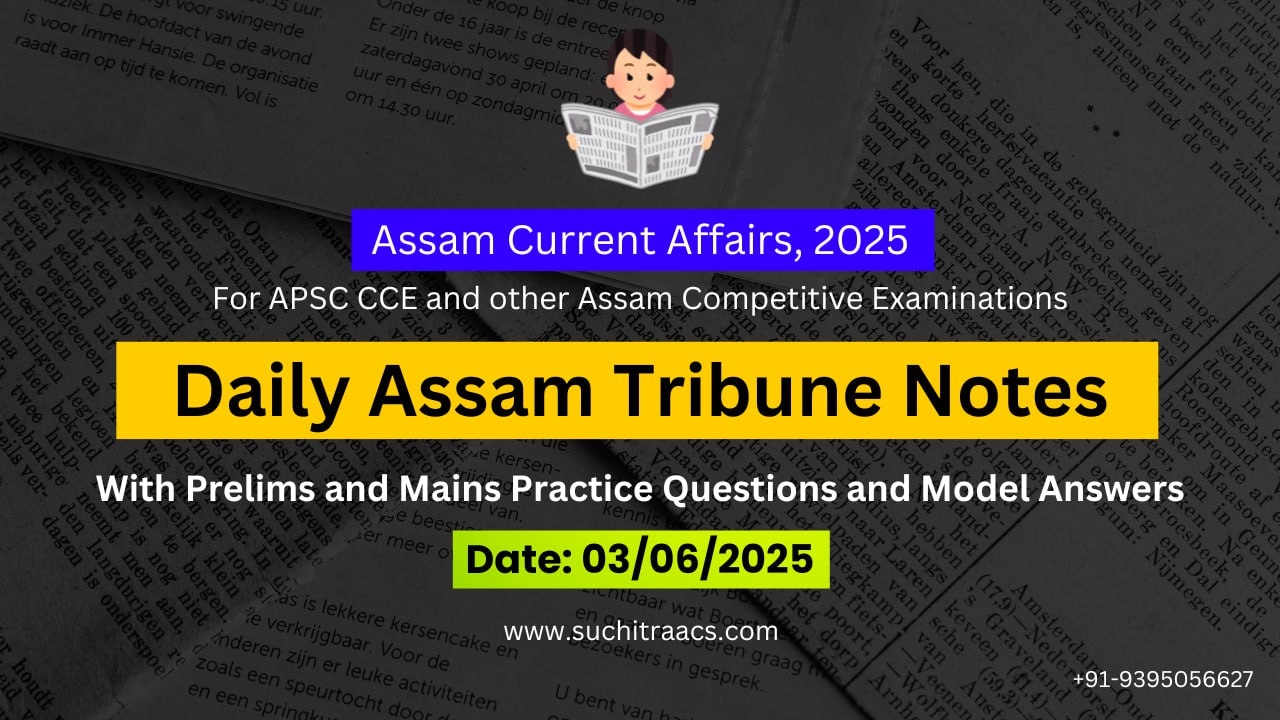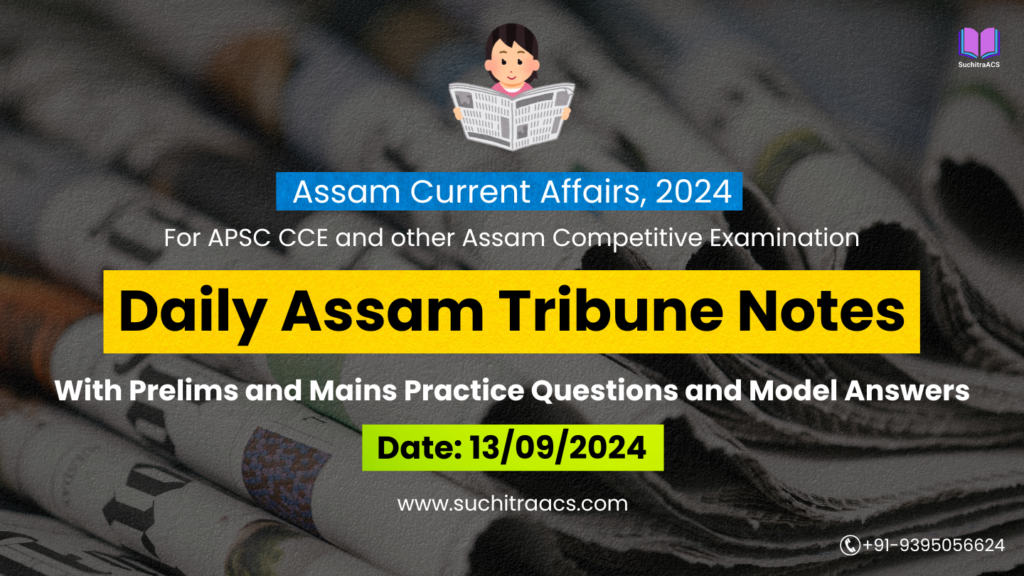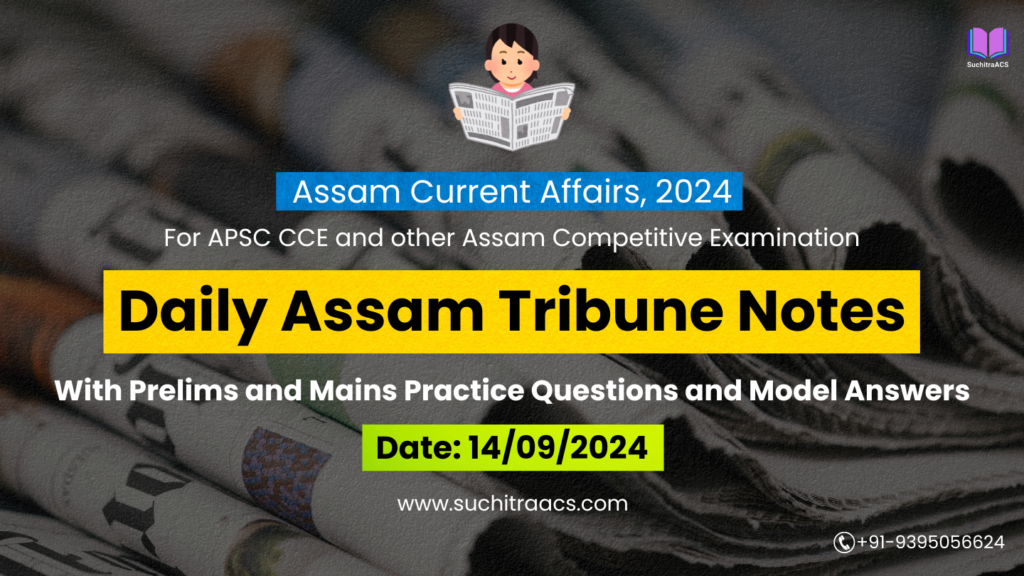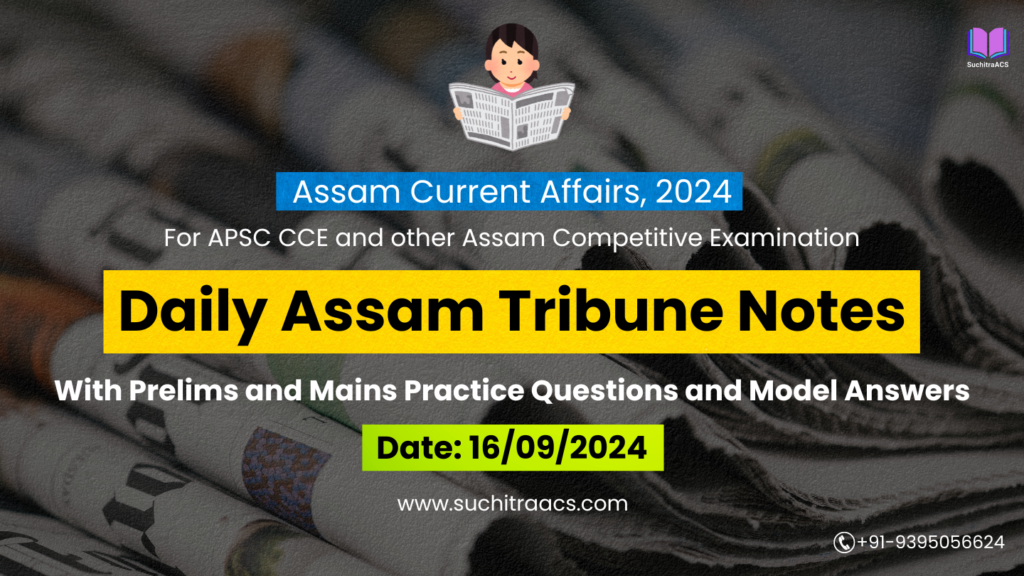APSC Current Affairs: Assam Tribune Notes with MCQs and Answer Writing (03/06/2025)
For APSC CCE and other Assam Competitive examinations aspirants, staying updated with current affairs is vital. This blog covers most important topics from the Assam Tribune today (03-06-2025). These issues are key for both APSC Prelims and Mains preparation, offering insights into the APSC CCE Syllabus.
✨ APSC CCE Online Coaching, 2026

🤝 Assam-Meghalaya Joint Initiative to Solve Guwahati Urban Flooding
📘 GS Paper 2: Inter-State Relations | Cooperative Federalism | Governance
📘 GS Paper 3: Disaster Management | Urban Infrastructure | Environmental Management
📘 GS Paper 5 (APSC): Assam – Urban Issues | Water Management | Regional Development
🔹 Introduction
The states of Assam and Meghalaya have taken a cooperative step to address one of the most persistent urban issues in the Northeast—urban flooding in Guwahati. In a high-level meeting between Chief Ministers Himanta Biswa Sarma and Conrad Sangma, the two states agreed to work jointly on water management, a satellite mapping survey, and future engineering interventions. This marks a significant shift toward collaborative disaster governance in the Northeast.
🔑 Key Points
| Feature | Description |
| Stakeholders | Assam & Meghalaya Governments; NESAC; IIT Roorkee |
| Issue Addressed | Urban flooding in Guwahati, caused partly by water inflow from Meghalaya |
| Survey Plan | Satellite mapping by NESAC to identify flood dynamics & catchment areas |
| Engineering Partner | IIT Roorkee to provide technical solution based on mapping |
| Timeline | Satellite survey to be completed in 3 months (by Sept 2025) |
| Other Projects | Joint development of Kulsi Power & Irrigation Project (55 MW) |
| Border Trust Building | 5 disputed boundary areas to be resolved by August 15 |
🧠 Prelims Pointers
NESAC: North Eastern Space Applications Centre – a joint initiative of ISRO & NEC
Kulsi River: A south bank tributary of the Brahmaputra, passing through Assam and Meghalaya
Urban Flooding: Defined as inundation due to poor drainage, unplanned development, or upstream runoff
Smart Cities Mission: Guwahati is a smart city with flood-resilient infrastructure goals
Asom Mala Scheme: Assam government’s infrastructure development initiative linked with this cooperation
📝 Mains Pointers
A. Importance of the Collaboration
Recognizes that floods are not state-bound but part of a shared river basin issue
Assam and Meghalaya jointly acknowledging hydrological interdependence
Sets an example of collaborative federalism in disaster risk mitigation
Use of space technology and engineering expertise for sustainable urban management
B. Major Challenges
| Challenge | Explanation |
| Cross-border Catchment Runoff | Water from Meghalaya’s uplands floods Khanapara, Beltola, and Zoo Road |
| Encroachment on Drains & Wetlands | Unregulated urban expansion in Guwahati has narrowed natural flow paths |
| Lack of Coordinated Data | Earlier responses were fragmented due to absence of shared topographic data |
| Political Sensitivities | Border disputes and shared infrastructure demand strong political will |
C. Government Initiatives
Tripartite Coordination: Between Assam, Meghalaya, and Central technical bodies like NESAC
IIT Roorkee: To provide hydrological engineering models based on satellite data
Kulsi Joint Project: To address both power generation and irrigation for farmers on both sides
Boundary Resolution Roadmap: Pillars to be installed in 5 areas by Independence Day 2025
D. Way Forward
📡 Establish a Joint Urban Flood Monitoring System using real-time rainfall and river-level data
🛑 Enforce zoning regulations against construction on flood-prone zones and wetlands in Guwahati
🛠️ Implement nature-based solutions like wetland revival and rainwater harvesting
🤝 Create a permanent inter-state task force on environmental disaster issues
🧾 Link water management plans with the Smart Cities Mission and State Action Plan on Climate Change (SAPCC)
📑 Relevant Reports & Frameworks
NDMA Urban Flood Guidelines (2010)
India State of Forest Report (ISFR) – highlights land use change in NE states
Assam State Disaster Risk Reduction Roadmap (2022-30)
CAG Audit on Urban Infrastructure (Assam 2021) – flagged poor drainage planning
NITI Aayog Report on Northeast Water Security (2023)
🧩 Conclusion
The Assam-Meghalaya flood cooperation reflects a mature governance approach that prioritizes science, inter-state trust, and community safety. If implemented effectively, this initiative could serve as a model for cooperative urban disaster resilience not just in the Northeast but across India’s interdependent geographies.
🛡️ India’s S-400 Missile Deployment Near China Border: Strategic Implications for the Northeast
📘 GS Paper 2: International Relations | India-China Border Issues
📘 GS Paper 3: Internal Security | Defence Technology | Strategic Infrastructure
📘 GS Paper 5 (APSC): Security in Northeast | Border Management | Role of Armed Forces
🔹 Introduction
India has now completed the deployment of all five units of the S-400 Triumf air defense system, including one near the China border in the Northeast. The move comes amid growing military and strategic concerns in the Indo-Tibetan region, especially after the 2020 Galwan standoff and repeated Chinese incursions near Arunachal Pradesh. The system’s deployment significantly enhances India’s air defense shield, covering key border zones and strategic installations in Assam and Arunachal.
🔑 Key Points
| Feature | Description |
| System Name | S-400 Triumf (NATO codename: SA-21 Growler) |
| Origin | Russia; deal signed in 2018 (₹39,000 crore for 5 units) |
| Capabilities | Intercepts aircraft, cruise missiles, drones up to 400 km range |
| Deployed In | Punjab, Rajasthan, Western India, Siliguri corridor, and now Northeast |
| NE Deployment Utility | Protects Siliguri corridor, Tezpur Airbase, Tawang sector, and Guwahati |
| Strategic Partner | Russia (despite CAATSA pressures from the USA) |
🧠 Prelims Pointers
S-400 System Range: Up to 400 km with multiple target tracking (up to 80 simultaneously)
Siliguri Corridor (Chicken’s Neck): Narrow stretch connecting NE India to the mainland
Tezpur Airbase: One of the most strategically important airbases under Eastern Air Command
CAATSA: U.S. law (Countering America’s Adversaries Through Sanctions Act) that threatens sanctions for major Russian defense deals
Advanced Radars: S-400 includes phased array radar and autonomous command vehicles
📝 Mains Pointers
A. Strategic Importance of the Northeast Deployment
Acts as a deterrent against Chinese aerial aggression, especially in Arunachal and Sikkim sectors
Shields key military and civilian installations like Tezpur, Missamari, and Guwahati
Covers high-risk areas like Tawang, Bum La, and the Subansiri Valley, frequent incursion zones
Enhances India’s ability to maintain airspace superiority and coordinate with the Air Force
Protects the vulnerable Siliguri Corridor, essential for troop and supply movement to NE states
B. Challenges in Operationalizing the System
| Challenge | Explanation |
| Logistical Complexity | Transporting and maintaining such advanced tech in hilly terrain is difficult |
| Harsh Weather Conditions | High altitude and extreme cold may affect radar and missile electronics |
| Geopolitical Sensitivities | May provoke stronger Chinese counter-deployments or diplomatic protests |
| Supply Chain Risk | Dependency on Russian parts amid global sanctions and Ukraine war impacts |
C. Broader Security Implications
Enhances India’s multi-layered air defense architecture (with Akash, Barak-8, Iron Dome proposals)
Reinforces India’s stand on military self-reliance and preparedness in border zones
Complements infrastructure buildup under Vibrant Villages Programme in border districts
May influence regional actors (e.g., Bhutan, Bangladesh) to recalibrate airspace policies
Adds weight to India’s tri-service command proposal in the Northeast
D. Way Forward
🔄 Ensure indigenous development of air defense systems (e.g., DRDO’s XRSAM) as long-term alternative
🛰️ Integrate S-400 with satellite-based and early warning radar systems in NE
🔧 Train local technicians for maintenance autonomy
🤝 Use India-Russia defense ties to push for technology transfer or co-production
🗺️ Conduct regular aerospace defense drills involving NE states and civilian agencies
📑 Related Policies & Frameworks
India’s Defence Procurement Procedure (DPP)
National Defence Strategy (NDS) – emphasizes integrated deterrence
Make in India in Defence – push for indigenous systems like Akash NG, QRSAM
Northeast Special Infrastructure Development Scheme (NESIDS) – infrastructure in border regions
SCO & BRICS – forums where India-Russia military cooperation is often discussed
🧩 Conclusion
The deployment of the S-400 system in the Northeast marks a strategic milestone in securing India’s vulnerable border regions. In an era of evolving threats, such systems not only provide a technological edge but also boost regional morale and reinforce India’s stance on protecting its territorial sovereignty through modern deterrence.
⚕️ Assam’s Strategy to Prevent Post-Flood Disease Outbreaks
📘 GS Paper 2: Governance | Health Policies | Disaster Response
📘 GS Paper 3: Disaster Management | Public Health Infrastructure
📘 GS Paper 5 (APSC): Assam – Public Health | Flood Management | Disease Control
🔹 Introduction
With floods displacing thousands across 19 districts and contaminating drinking water sources, the Assam Health Department has launched a multi-agency response plan to prevent post-flood disease outbreaks. Floods in Assam routinely lead to outbreaks of diarrhoea, cholera, skin infections, and vector-borne diseases such as malaria and dengue. Proactive surveillance, public health campaigns, mobile medical units, and interdepartmental coordination have been rolled out as part of this strategy.
🔑 Key Points
| Element | Description |
| Govt. Action | Activation of multi-departmental flood health cells in all districts |
| Diseases Targeted | Diarrhoea, cholera, dysentery, malaria, dengue, skin diseases |
| Health Staff Deployed | Doctors, ANMs, ASHAs, pharmacists, lab technicians |
| Surveillance Measures | Daily data collection by Integrated Disease Surveillance Programme (IDSP) |
| IEC Campaigns | Awareness drives on clean drinking water, hygiene, ORS use |
| Relief Infrastructure | Stockpiling of ORS, chlorine tablets, essential medicines in camps |
| Coordination Bodies | Directorate of Health, ASDMA, PHED, Animal Husbandry, Urban Development |
🧠 Prelims Pointers
IDSP (Integrated Disease Surveillance Programme): National network for outbreak detection under the NHM
ORS (Oral Rehydration Solution): Simple, low-cost therapy for dehydration during diarrhoea outbreaks
ASHAs: Accredited Social Health Activists; grassroots health workers under NHM
Vector-Borne Diseases: Spread by mosquitoes, flies, or ticks—includes malaria, dengue, JE
Zoonotic Disease Control: Animal husbandry departments activated due to possible livestock infections
📝 Mains Pointers
A. Importance of Flood-Health Linkage
Assam’s geography leads to annual floods, which cause waterlogging, poor sanitation, and stagnant water—ideal for disease spread
Health impacts of floods are disproportionately higher in rural, tribal, and tea garden communities
Direct effect on maternal and child health, food security, and school attendance
Disease outbreaks post-floods increase burden on rural PHCs, CHCs, and mobile health teams
B. Challenges in Flood-Linked Disease Prevention
| Challenge | Explanation |
| Contaminated Water Sources | Tube wells and ponds polluted by floodwaters |
| Disrupted Health Access | Sub-centres and PHCs often inaccessible due to waterlogging |
| Poor Hygiene Infrastructure in Camps | Overcrowding, lack of clean toilets, menstrual hygiene risks |
| Shortage of Trained Staff | Rural and flood-affected areas face deployment bottlenecks |
| Lack of Real-Time Data | Surveillance delays hamper outbreak response |
C. Govt. Measures Taken
Deployment of mobile health teams to remote relief camps
ORS packets and halogen tablets distributed in high-risk villages
Round-the-clock health help desks established in district hospitals
Interdepartmental coordination for sanitation, water supply, livestock care
Integration with PHED to chlorinate wells and water tanks
IDSP-trained field workers reporting suspected cases daily
D. Way Forward
📊 Use digital disease mapping tools for real-time outbreak prediction
🧼 Deploy portable water purifiers and solar disinfection (SODIS) kits
🧾 Mandatory flood health preparedness protocols at district level under ASDMA
👩⚕️ Provide flood-specific training to ASHAs and ANMs on hygiene promotion and disease detection
🌾 Integrate with climate-resilient health strategy under National Adaptation Fund for Climate Change
🏥 Strengthen PHC infrastructure on raised platforms in flood-prone blocks
📑 Relevant Policies & Frameworks
National Health Mission (NHM)
IDSP Guidelines – Surveillance during disasters
Assam Public Health Act (being drafted)
State Disaster Risk Reduction Roadmap (2022–2030)
WHO Guidelines on Health and Flood Management
🧩 Conclusion
Assam’s post-flood health strategy is a vital convergence of disaster response and public health governance. As floods become more frequent and intense due to climate change, institutionalizing a resilient, data-driven, and people-centric flood-health response model is the need of the hour. Proactive planning today ensures fewer lives lost tomorrow.
APSC Prelims Practice Questions
✅ Topic 1: Assam-Meghalaya Joint Initiative on Guwahati Flooding
1. Which of the following are correctly associated with the Guwahati urban flood mitigation initiative?
- NESAC will conduct satellite-based flood mapping.
- IIT Madras is leading the engineering model.
- The Kulsi Project involves joint hydropower and irrigation development.
- The survey will also demarcate state boundaries.
Choose the correct code:
A. 1, 2 and 4 only
B. 1 and 3 only ✅
C. 1, 3 and 4 only
D. 2 and 3 only
🧠 Explanation:
- Statement 1: Correct. NESAC is leading satellite mapping of catchments.
- Statement 2: Incorrect. It is IIT Roorkee, not IIT Madras.
- Statement 3: Correct. Kulsi Project is a joint hydro and irrigation initiative.
- Statement 4: Incorrect. While boundary talks are ongoing, this flood survey is not linked to border demarcation.
2. The Kulsi River, recently in the news for an interstate power project, is:
A. A north bank tributary of the Brahmaputra
B. A south bank tributary of the Brahmaputra ✅
C. A distributary of the Barak River
D. A tributary of the Dhansiri River
🧠 Explanation:
The Kulsi River flows through Meghalaya and Assam and joins the Brahmaputra from the south bank.
✅ Topic 2: Deployment of S-400 Missile System in Northeast
3. Consider the following statements about the S-400 Triumf Air Defense System:
- It is capable of targeting aircraft, drones, and ballistic missiles up to 400 km.
- The system is entirely indigenously developed by DRDO.
- One unit has been deployed to cover the Siliguri Corridor and Northeast region.
Which of the above statements is/are correct?
A. 1 and 2 only
B. 1 and 3 only ✅
C. 2 and 3 only
D. 1, 2 and 3
🧠 Explanation:
- Statement 1: Correct – S-400 has a range of 400 km for aerial targets.
- Statement 2: Incorrect – It is a Russian-origin system, not DRDO-made.
- Statement 3: Correct – One unit is deployed in Northeast India to secure critical border zones.
4. The Siliguri Corridor, often mentioned in defense contexts, is significant because:
A. It hosts India’s largest airbase
B. It is a mountain pass connecting India with Bhutan
C. It is a narrow stretch linking the Northeast with mainland India ✅
D. It is the boundary line between India and Bangladesh
🧠 Explanation:
The Siliguri Corridor, also known as the Chicken’s Neck, is a narrow land strip in West Bengal connecting mainland India to the Northeast.
✅ Topic 3: Assam’s Post-Flood Disease Strategy
5. With reference to Assam’s flood-related public health response, consider the following:
- IDSP is used for daily disease surveillance during floods.
- ORS and halogen tablets are stockpiled for emergency distribution.
- ASHAs and ANMs are part of the front-line response team.
- The strategy is led by NITI Aayog’s Health Division.
Which of the above statements are correct?
A. 1, 2 and 3 only ✅
B. 1, 3 and 4 only
C. 2 and 4 only
D. 1, 2, 3 and 4
🧠 Explanation:
- Statements 1, 2, and 3 are all correct – IDSP surveillance, distribution of ORS/chlorine, and frontline health workers are part of the response.
- Statement 4 is incorrect – the strategy is led by state health departments, not NITI Aayog.
6. Match the following disease-control interventions with their targets:
| Intervention | Target Problem |
| A. Chlorine Tablets | 1. Water disinfection |
| B. Fogging Operations | 2. Mosquito vector control |
| C. ORS Packets | 3. Diarrhoea and dehydration |
| D. Animal Husbandry Teams | 4. Zoonotic disease containment |
Choose the correct match:
A. A-1, B-2, C-3, D-4 ✅
B. A-3, B-4, C-1, D-2
C. A-1, B-3, C-4, D-2
D. A-2, B-1, C-3, D-4
🧠 Explanation:
All four pairs are correctly matched to standard flood health response protocols.
7. Assertion (A): Post-flood periods in Assam often see outbreaks of diarrhoeal and vector-borne diseases.
Reason (R): Floodwaters contaminate drinking sources and create stagnant pools ideal for mosquito breeding.
Choose the correct answer:
A. Both A and R are true, and R is the correct explanation ✅
B. Both A and R are true, but R is not the correct explanation
C. A is true, but R is false
D. A is false, but R is true
🧠 Explanation:
This is a classic case of cause and effect: R directly explains A, making option A correct.
APSC Mains Practice Question
📝 Mains Question (GS Paper 3 – Disaster Management | Public Health | Governance):
Q. Post-flood health risks in Assam pose a serious governance and disaster management challenge. Examine the public health impacts of floods in Assam. What strategies can be adopted to build a resilient flood-health response system in vulnerable regions?
📘 Model Answer
Introduction
Floods are a recurring disaster in Assam, affecting over 19 districts annually, displacing lakhs, and damaging critical infrastructure. Beyond the immediate damage, floods create a public health emergency, leading to outbreaks of diarrhoeal diseases, vector-borne illnesses, skin infections, and disruptions to maternal and child health services. As climate variability increases, so does the risk of health crises post-floods, necessitating an integrated and anticipatory approach.
Public Health Impacts of Floods in Assam
| Health Risk | Description |
| Waterborne Diseases | Contaminated water sources lead to diarrhoea, cholera, dysentery |
| Vector-Borne Diseases | Stagnant water triggers malaria, dengue, chikungunya outbreaks |
| Skin and Eye Infections | Long exposure to water, poor hygiene in camps |
| Nutrition and Immunity | Floods disrupt food supply chains, affecting children and lactating women |
| Mental Health Issues | Anxiety, trauma, and stress in displaced populations |
| Livestock Diseases | Zoonotic risks increase when livestock die or mingle with floodwater |
Challenges in Flood-Health Management
- Weak Primary Healthcare Access
- Many PHCs and Sub-Centres are submerged or inaccessible during floods.
- Overcrowded Relief Camps
- Poor sanitation, lack of menstrual hygiene kits, and disease transmission hotspots.
- Shortage of Medical Supplies & Staff
- Sudden demand spikes stress the limited health infrastructure.
- Delayed Disease Surveillance
- Integrated Disease Surveillance Programme (IDSP) often reports with a lag.
- Coordination Gaps
- Multiple departments (Health, ASDMA, PHED) may not act in synergy.
Recent Government Measures
- Activation of district-level health control rooms and flood-health cells
- Pre-positioning of ORS, halogen tablets, and essential drugs in high-risk blocks
- Deployment of mobile medical units, ASHAs, ANMs, and lab technicians
- Daily health surveillance reports submitted to IDSP and ASDMA
- Chlorination of water sources and fogging for vector control in camps
Way Forward: Building a Resilient Health-Flood System
A. Policy & Planning
- 🧾 Develop a State Flood-Health Preparedness Protocol, updated annually
- 🗺️ Integrate climate risk mapping with district health plans
B. Infrastructure
- 🏥 Construct elevated PHCs and Sub-Centres in flood-prone zones
- 🚐 Ensure fully equipped mobile clinics for inaccessible areas
C. Technology and Surveillance
- 📡 Use real-time outbreak alert tools via GIS and IDSP platforms
- 📱 Create an SMS-based public alert system for disease symptoms and precautions
D. Human Resources and Community Engagement
- 👩⚕️ Train ASHAs and local volunteers in epidemic control and hygiene promotion
- 📢 Run IEC campaigns in flood season on water purification and ORS usage
E. Inter-departmental Coordination
- 🤝 Conduct mock drills involving Health, PHED, ASDMA, and Education departments
- 🐄 Collaborate with Animal Husbandry to monitor and control zoonotic threats
Conclusion
Post-flood public health management in Assam is not just a medical challenge but a governance test. As extreme weather events increase due to climate change, the state must invest in a climate-resilient, technology-integrated, and community-driven health response system. The long-term goal should be to transform disaster episodes into opportunities for health system strengthening and social equity.
✨ APSC CCE Courses, 2025-26 offered by SuchitraACS


🔔 Join Our WhatsApp Study Group!
For exclusive access to premium quality content, including study materials, current affairs, MCQs, and model answers for APSC CCE and other Assam competitive exams.
Click here to join: SuchitraACS Study WhatsApp Group
📚 Want to know more about SuchitraACS’s most affordable courses?
Click here to know more: SuchitraACS Courses for APSC CCE and Assam Competitive Examinations




